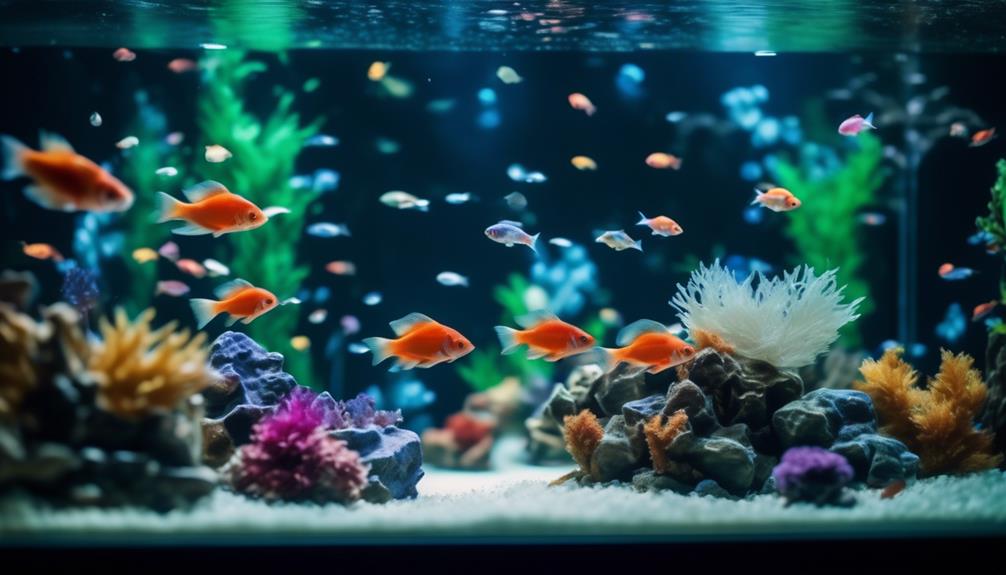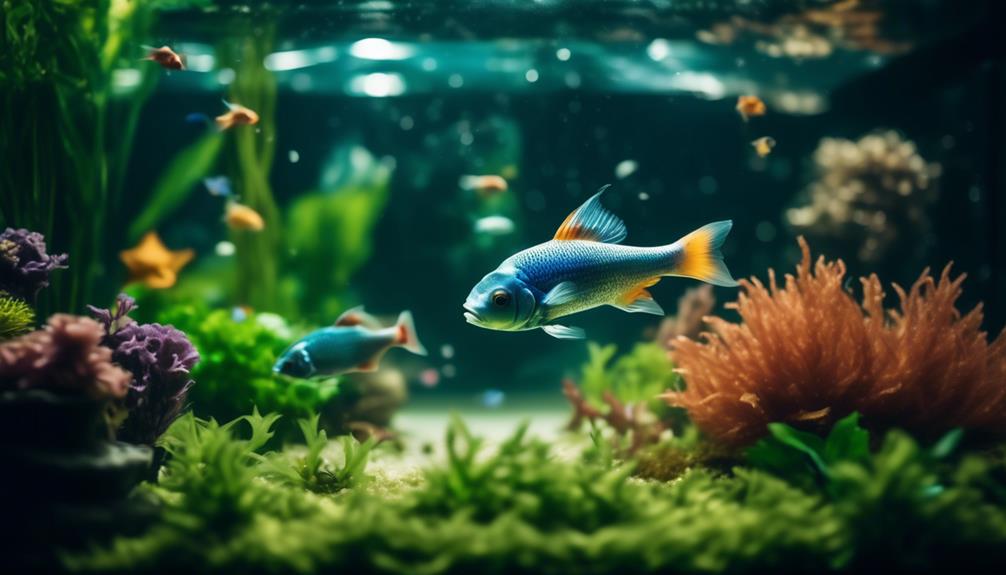Aquarium salt has emerged as a go-to solution for fish enthusiasts seeking to enhance the health and well-being of their aquatic pets. Its numerous advantages, including the provision of essential electrolytes and its efficacy against bacteria, fungus, and external parasites, have made it a staple in aquarium treatment and prevention.
However, understanding the proper usage and precautions associated with aquarium salt is crucial for maximum effectiveness. Furthermore, knowing the appropriate treatment levels and concentrations, as well as the salt tolerance of different fish species, is essential.
By unraveling the potential of aquarium salt and following the recommended treatment process, aquarium owners can tap into its healing power and ensure the optimal vitality of their beloved aquatic companions.
Key Takeaways
- Aquarium salt provides essential electrolytes for fish and can effectively combat bacteria, fungus, and external parasites.
- Proper usage and precautions are important to avoid misuse and the development of resistant diseases.
- Treatment levels and concentrations of aquarium salt vary depending on the illness and fish species.
- The salt treatment process involves gradually increasing salt concentration, observing the fish's health, and using water changes to remove the salt if necessary.
Benefits of Aquarium Salt
Aquarium salt offers a range of benefits for fish health and disease prevention. It is commonly used in both freshwater tanks and saltwater fish aquariums.
One of the main benefits of aquarium salt is that it provides essential electrolytes for fish. These electrolytes help to maintain proper osmoregulation, which is crucial for fish health and overall well-being.
Additionally, aquarium salt has been found to be effective against bacteria, fungus, and external parasites. It works by raising the salinity of the water, causing dehydration in pathogens. Osmosis seeks to balance salt concentration, which dehydrates microorganisms faster than fish.
However, it is important to note that not all microorganisms can withstand higher salinity, making salt treatment not a 100% guaranteed solution. Nonetheless, aquarium salt is a valuable tool in the prevention and treatment of fish diseases when used correctly.
Proper Usage and Precautions
When using aquarium salt, it is crucial to follow proper usage and precautions to ensure the well-being of the fish.
Misuse of aquarium salt can have serious consequences and may lead to long-term effects on the fish.
It is important to note that salt should not be used daily as a preventative measure or health booster, as this can result in the development of resistant diseases.
Salt should only be used sparingly when necessary, and accurate measurements and careful usage are essential.
While salt can be a powerful tool when used correctly, it is not a guaranteed solution and may not eliminate all pathogens and parasites.
Therefore, it is important to monitor the fish closely and observe any changes in their health.
Treatment Levels and Concentration

Different illnesses require different treatment levels and concentrations of aquarium salt for effective healing. It is important to understand that each treatment level has a specific purpose and should be used accordingly.
Level 1 treatment, which involves adding 1 tablespoon of salt per 3 gallons of water, is suitable for mild illnesses or as a preventive measure.
Level 2 treatment, with 1 tablespoon of salt per 2 gallons of water, is used for moderate conditions.
For severe illnesses, level 3 treatment is recommended, with 1 tablespoon of salt per 1 gallon of water. It is crucial to note that the concentration of salt should be gradually increased to avoid shocking the fish.
Additionally, it is worth considering that some fish species are more salt tolerant than others, so their individual needs should be taken into account.
Salt Treatment Process
To properly utilize the healing power of aquarium salt, it is essential to follow a systematic salt treatment process. This process involves several steps to ensure the effectiveness of the treatment.
- Salt concentration levels: Depending on the illness and the tolerance of the fish species, different salt concentration levels are used. These range from 1 tablespoon of salt per 3 gallons of water for level 1 treatment, to 1 tablespoon of salt per 1 gallon of water for level 3 treatment.
- Removing salt through water changes: After the desired treatment period, the salt needs to be removed from the aquarium. This is done through regular water changes where a portion of the water is replaced with fresh, salt-free water.
- Observation: It is important to observe the fish for at least a week after the salt treatment to ensure that the illness does not reoccur.
- Adjusting salt concentration: If the disease returns, it may be necessary to increase the salt concentration gradually to achieve a more effective treatment.
Following this salt treatment process can help fish enthusiasts effectively utilize the healing properties of aquarium salt.
Salt in Quarantine for Fish

Continuing the discussion on the effective utilization of aquarium salt, another important aspect to consider is its role in quarantine for fish.
Using salt in fish quarantine can be beneficial for several reasons. Firstly, it helps to prevent the spread of diseases and parasites from the quarantined fish to the rest of the aquarium. Salt treatment in quarantine can eliminate many pathogens and parasites through osmosis, as it raises the salinity of the water, dehydrating microorganisms faster than the fish.
However, it is important to note that some microorganisms can withstand higher salinity levels. Therefore, salt is not a 100% guaranteed solution for all diseases. Additionally, caution should be exercised when using salt treatment for long periods, as it may have long-term effects on the fish's health.
Proper dosage and gradual concentration increase should be followed to minimize any potential risks.
Frequently Asked Questions
Can Aquarium Salt Be Used in Freshwater Tanks?
Yes, aquarium salt can be used in freshwater tanks. It can provide potential benefits for fish health, such as supplying essential electrolytes and combating bacteria, fungus, and external parasites.
How Long Does It Take for Aquarium Salt to Start Working?
The effectiveness of aquarium salt varies depending on the specific illness being treated. Generally, it can take a few days to a couple of weeks for aquarium salt to start working and show visible improvements in fish health.
Can Aquarium Salt Be Harmful to Certain Fish Species?
Aquarium salt can be harmful to certain fish species. It is important to research the specific needs of each species before using salt as a treatment. Alternatives such as medication or adjusting water parameters should be considered to minimize potential risks.
Is It Safe to Use Aquarium Salt With Live Plants in the Tank?
Using aquarium salt for plant growth can have negative effects on aquarium water quality. The salt can increase salinity, which can harm the plants and disrupt the balance of the ecosystem.
Can Aquarium Salt Be Used in Conjunction With Other Medications or Treatments?
Aquarium salt can be used as a natural remedy for fish diseases, but it is not recommended as a preventive measure against common fish ailments. Its usage in conjunction with other medications or treatments depends on the specific situation and should be discussed with a veterinarian.
Conclusion
In conclusion, aquarium salt is a valuable tool in maintaining the health and well-being of fish. Its benefits include providing essential electrolytes, combating bacteria, fungus, and external parasites.
Proper usage and precautions are necessary to ensure its maximum potential, including understanding treatment levels and concentrations. By following the recommended salt treatment process, aquarium owners can unlock the healing power of aquarium salt and promote the overall health of their aquatic pets.

